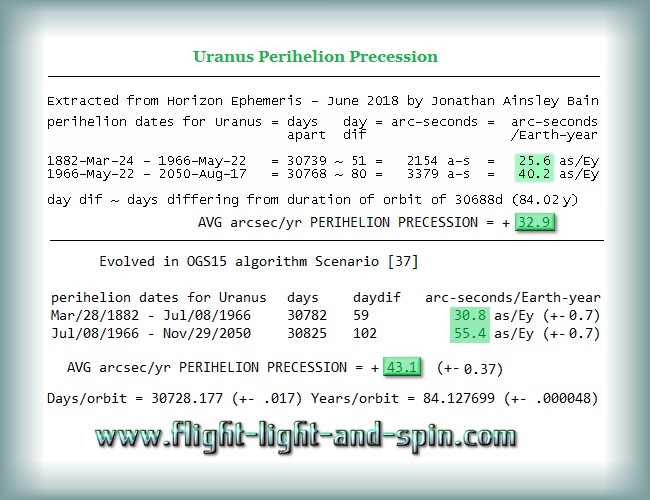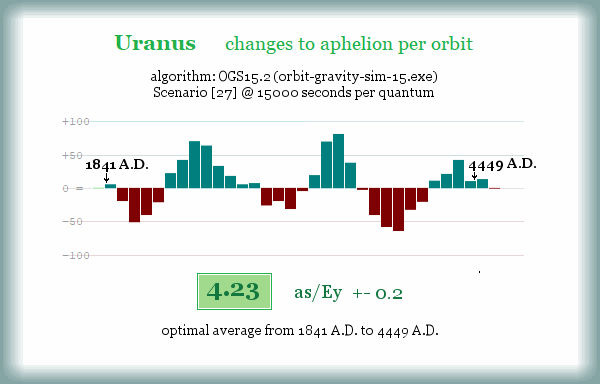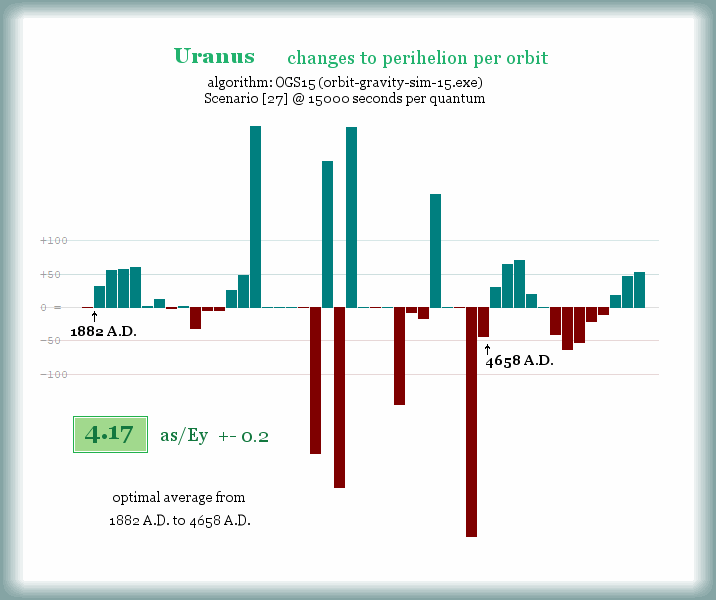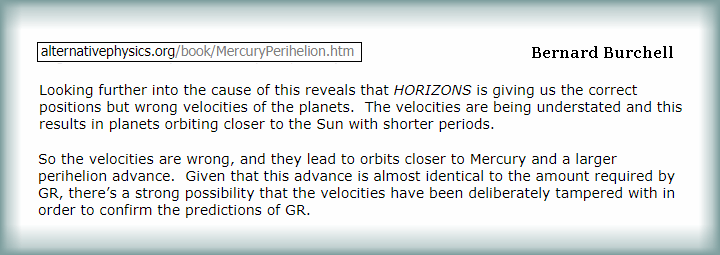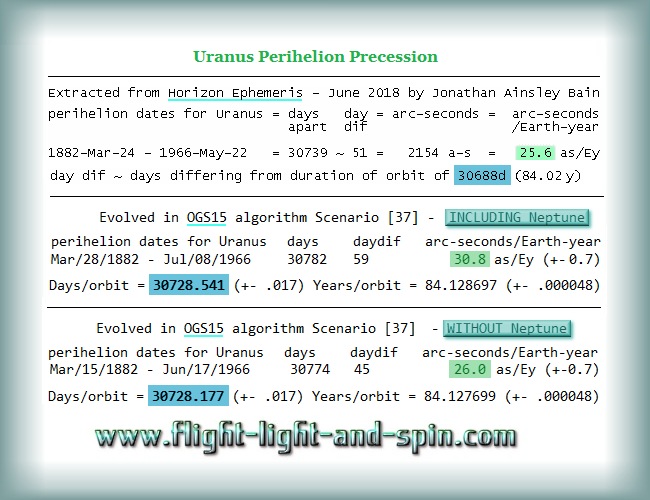Two significant features here:
Firstly the effect Neptune has on Uranus' orbit is
just 0.001
year (0.36
days). Whereas the variety of given durations to Uranus' orbit
we saw earlier from within NASA differ by 6
times that (2.3 days). In comparison the Horizon
Ephemeris is 6 days different, whereas the
widely quoted value of 84.323 years for Uranus'
orbit is a duration 14 days longer than NASA's
shortest value.
So
it is perhaps a popular myth that variations to Uranus's orbit
resulted in the discovery of Neptune. After all, Galileo clearly
could see Jupiter's Galilean moons, with Europa having a visibility
magnitude of about 5.6, whilst Uranus itself
has a visibility magnitude of, also 5.6!
They may simply not have noticed Uranus for the two centuries
between Galileo and the discovery of Uranus. The problem here
is that the effect of Uranus on Saturn is of similar proportion
to the effect of Neptune on Uranus. But Uranus was said to be
simply noticed, not predicted, like Neptune was.
But the various opinions on the duration of Uranus' orbit, as
well as the theoretical filibuster which comprises Einstein's
formula suggest that its not just a decision as to whether current
understanding of gravity is weaker than that of the 1800's.
The widespread acceptance Einstein's pseudoscience alone is
proof of the degeneration of academic process.
The discovery of Neptune could simply have been as a result
of angular displacement to Uranus, not actual distances or durations
of the orbit. But that claim may simply have been to bolster
academic territory and perceived value of mathematical process
over the comparatively simpler astronomical observation. With
Uranus potentially visible to telescopes for 200
years or so before its official discovery, we should be skeptical
about such claims; however widespread they have become.
Thus it may be true that their maths was superior at least to
that of the 20th century; and it may also be
a myth that Neptune was discovered by calculations on Uranus'
orbit. It could very easily be a myth as to who discovered of
Uranus too. Academia is rife with opportunist claims. Such speculation
is of course only the first step to proof anyways. But the radical
various claims as to the parameters of Uranus' orbit leave much
to be desired, and open the door to such speculation.
I do calculate a variation of 15 days over
numerous centuries to the various future orbits of Uranus. But
the orbit 1800 to 1884 I get
at 30727 days. From 1884 to
1968 the duration is 30723
days, a shrinking of only 4 days in the only
2 orbits of Uranus ever observed - that we
know of. This is identical the Horizon Ephemeris data earlier
which, also showed the orbit contract by four days between those
two orbits, even if the other parameters differ.
So if we marginally disagree on the duration of the orbit and
the dates of perihelion and aphelion, the proportional difference
of 4 days between orbits is not different between
models - if we have correctly evolved the gravitational alteration
of the other planets to Uranus's orbit. So the disagreements
in perihelion and aphelion dates can only be a result of them
using statistical and not evolutionary processes. After all,
the OGS15 starting position and direction of
the velocity vectors comes directly from their database.
The second interesting feature of the table depicted
previously, is that when I exclude Neptune completely from the
calculation of the Perihelion Precession of Uranus, the result
is virtually identical to that in the Horizon Ephemeris data:
26 arc-seconds per Earth-year! Make of that
what you will, but I am only completely certain of one thing:
my formula for 3d-n-body-gravity is
logically correct within itself. Everyone else does not even
publish their methodology and formulae.
The 26 as/Ey extracted from Horizon Ephemeris
depends on the largely varying question as to the duration of
Uranus orbit. But with OGS15 I simply take
the angle between Uranus and the Sun at the two perihelions
in radians. Those values are generated for the user next to
the label 'Theta' in the 'data-drift.txt' database should you
wish to run the algorithm and double check the math.
Then I subtract one angle of the perihelion from the other,
and convert it into the standard units of measurement. That
result is a 100% correct angular geometry because
it has nothing to do with the duration of the orbit.
It is situations like this that have made this particular analysis
so vital. It is simply assumed by the public that the famous
organization is flawless, knows it all, and never lies because
it has an 'official' name rubber-stamped on it. As a logical
positivist, the imperative is to take nothing at face-value.
The primary method is to simply examine claims according to
their own internal logical consistency ... or lack thereof.
But it is certainly clear the Horizon Ephemeris is not an evolutionary
n-body-gravity model, because the velocity vector should
be the principle cause of the next position in a proper
evolutionary process.
I deal with this issue in more detail in the section: Sorting
Horizons, which demonstrates similar calculations regarding
Mercury's orbit.
So this section on Uranus serves only to show up the inconsistencies
in available data and theory. The published data at NASA varies
within that organization by 0.018% for the
duration of Uranus' orbit which is an amazing 1.35
million kilometers. Neptune only alters the position of Uranus
by 0.2 million kilometers in that orbit. Other
sources increase that error-margin to over 8
million km; 40 times the effect of Neptune.
The orbit of Neptune itself, however, is certainly going to
be even less accurate. |
